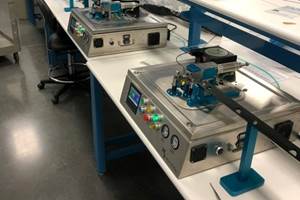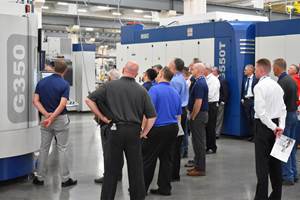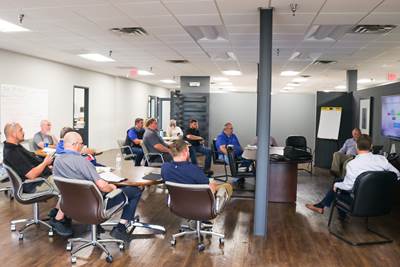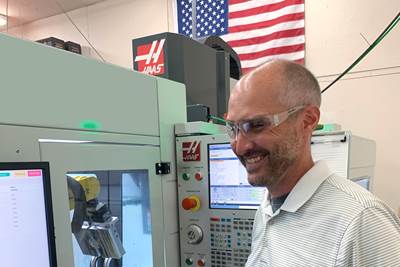Stars Slowly Align for Small Shop Merger
RPM Tool’s seemingly overnight expansion from a five-person machine shop to an almost 30-employee production business involved over a year and a half of planning.
Share




In January 2022, Matthew Robbins, founder and president of RPM Tool, announced on LinkedIn that his shop had acquired Holzmeyer Die and Tool, growing from a small, five-person shop to one with almost 30 employees. What went unsaid in the post was that the integration between the two Princeton, Ind., companies had been taking place for a year and half prior to the announcement. Also invisible from the surface? A support network in and out of the office, with Robbins crediting his success to everyone from his CPA and attorney to his wife to his steadfast employees on the shop floor.
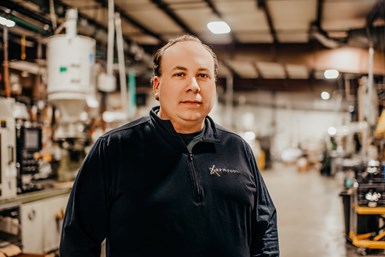
Matthew Robbins has spent the better part of two decades immersed in the ins and outs of toolroom-style business. By apprenticing with Holzmeyer’s owner for a year and a half before buying her company, he has familiarized himself with differences in staff and customer needs and has had time to develop an efficient structure for the merged RPM Tool. All images courtesy of RPM Tool.
Hurry Slowly
RPM Tool’s sales have tripled since Robbins founded the company in 2005. The shop operated primarily as a precision machining subcontractor for the automation industry, but also performed some die-building. Robbins had been looking to acquire shops with complementary capabilities — preferably production capabilities like stamping or molding — for five or six years before the opportunity arose with Holzmeyer, which fit the bill perfectly.
RPM Tool had machined production tooling for Holzmeyer for a decade when the widow of Holzmeyer’s founder decided to retire, reaching out to Robbins to discuss a sale. As part of the sale, Robbins apprenticed with her to learn the difference between running a toolroom as a business and running a production business with a supporting toolroom.
This apprenticeship was originally planned to last one year, with Robbins learning how to spot quality issues in production and how to best meet the needs of the company’s various customers — a subject that extended from determining which materials to stock for likely orders to learning customers’ requirements on box sizes and maximum part capacities. As Holzmeyer was an ISO 9001-certified shop, this apprenticeship was also to be an education in ISO requirements for Robbins. Between COVID and some delays with the attorneys and banks, this training period extended to a year and a half. The delay may have been for the best, however, as Robbins was able to form relationships with Holzmeyer’s established customers and smoothly transition over in what he describes as an almost “plug-and-play” experience.
Sticking Points
Even with this smoothing over and the two shops being “basically across the street,” as Robbins puts it, the work of merging the shops was still a lengthy experience. Moving equipment is one of the more obvious difficulties — RPM Tool decided to move all its equipment into the Holzmeyer building, requiring some rearranging on the shop floor and the creation of new airlines to handle the load of the new equipment. Renovations also included some electrical upgrades to handle the new equipment’s draw on the system, and a switch to LED lighting to both lower costs and improve shopfloor visibility.
Matthew Robbins’ year-and-a-half apprenticeship resulted in a better connection with his new customers, while the delays with his accountant and lawyers resolved in a favorable evaluation of Holzmeyer’s assets and a tax-friendly plan for merging Holzmeyer into RPM Tool.
Software also proved difficult to integrate, but not because of incompatible systems. Rather, RPM Tool didn’t use much beyond its CAD/CAM system, and integrating with Holzmeyer has required Robbins and the original RPM Tool employees to familiarize themselves with new systems and technologies, such as Mastercam programming. Another difficulty arose with design work: Holzmeyer’s chief designer passed away unexpectedly soon after the merger became official. As such, Robbins is searching for a new lead designer, and plans to invest in that designer’s preferred software.
Adopting ISO 9001 strategies has further required RPM Tool’s machine shop staff to learn from the former Holzmeyer production team. Robbins said his company previously “didn’t have the resources to necessarily keep good track of job costs or to save files for something we did,” but first-hand experience with the production team’s proven methods has encouraged the machine shop team to begin tracking costs and processes. At the time of writing, the machine shop is using email and folders of paper documents to track jobs, but Robbins hopes to make a full digital transition. As the production team was not fond of the digital job-tracking system it previously used, Robbins plans to find a new ERP system for the whole company at IMTS 2022 this fall.
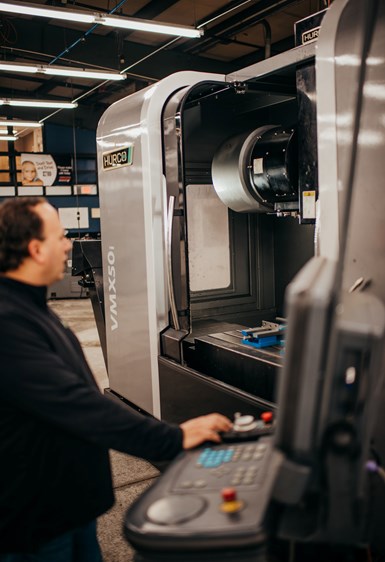
In March 2022, Robbins moved RPM Tool’s original equipment and personnel from the shop’s old building to the former Holzmeyer facility. The “new” equipment consists of three- and four-axis Hurco CNC milling machines, Hurco live-tool CNC lathes and Sodick wire EDMs, all of which are a far cry from Holzmeyer’s old, manual machines.
Looking Forward and Back
Even if he could redo the merger, Robbins would take the same approach: handle the challenges as they come, one at a time. “Nothing happens nearly as fast as you’d like, so it’s got to be loose,” he says, and this flexible approach served him well. His year-and-a-half apprenticeship resulted in a better connection with his new customers, while the delays with his accountant and lawyers resolved in a favorable evaluation of Holzmeyer’s assets and a tax-friendly plan for merging Holzmeyer into RPM Tool.
Looking ahead, Robbins is thankful he doesn’t have to reinvent the wheel at Holzmeyer, calling it a “huge blessing to just walk into a company that was already running successfully.” Aside from a few structural changes, he says, “All we did was change the signs out.” As for staffing, he says the two teams are excited to work more closely together, and the production manager will be staying on to supervise that side of the combined shop. Robbins will fill in as machine-shop manager for a time, but he hopes to promote a permanent manager from within. Robbins’ wife has also joined the company to manage accounting, payroll and benefits.
The future of RPM Tool is looking like one of organic growth. The job shop staff’s machining capabilities will enable the combined company to produce more of its production tooling in-house, shortening lead times for stamping dies and simple, mid-size molds. RPM Tool will continue to produce Holzmeyer’s automotive, HVAC, electronics and woodworking machine parts, while also offering machining capacity directly to clients instead of purely subcontracting it. In time, Robbins is looking to take on new parts where the shop can build its own tooling to run in full production.
Related Content
Lyndex-Nikken Collets Enable Accurate Small-Diameter Cutting
The MMC Mini-Mini collet chuck is well suited for high-speed machining applications where clearance is needed, such as die mold, aerospace and medical parts.
Read MoreIn Moldmaking, Mantle Process Addresses Lead Time and Talent Pool
A new process delivered through what looks like a standard machining center promises to streamline machining of injection mold cores and cavities and even answer the declining availability of toolmakers.
Read MoreFor This Machine Shop, Licensing Is the Answer to the Inventor’s Dilemma
Machine shops are natural inventors, but not necessarily suited to supporting and marketing a product. This Minnesota shop with an invention related to micromolding will share it through licensing.
Read MoreGrob Systems Inc. to Host Tech Event With Industry Partners
The 5-Axis Live technology event will highlight new machining strategies for optimizing the production of complex medical, aerospace and mold/die parts.
Read MoreRead Next
People-First Mindsets Improve Machine Shop Acquisitions
Focusing on the human side of the business — employee health, safety, success and growth — is the only way to satisfy both the buyer and seller.
Read MoreStarting with the End in Mind: An Exit Strategy for Machine Shops
John Shegda and Eric Wilhelm each had different ideas about how they wanted to phase into retirement. The exit strategies for the three successful manufacturing businesses the two men operated included a mix of seeking equity groups, selling the business, or transitioning into an employee stock ownership plan. All it took was a friendly suggestion from a mutual friend to set them on a different path.
Read More5 Reasons Why Machine Shop Ownership Is Changing
Mergers, acquisitions and other ownership changes are an effect of Boomer-age shop owners retiring, but only in part. Also important: The way we think about machining has changed.
Read More


























